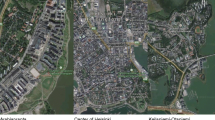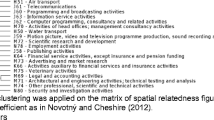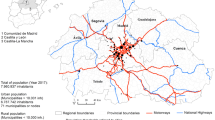Abstract
Based upon an hermeneutic approach, which explicitly takes into account the role space plays within the knowledge economy, the article is aimed at providing the geography of knowledge-based activities in the Paris metropolitan area and at depicting the shape of their external economies and agglomeration forces. The added value supplied by this paper consists in: a) the spatial extent covered (the Paris Metropolitan Region), in order to consider the role that the pivot city and the surrounding towns/cities jointly play within the urban regional structure; and b) the improved explicative capability of a hermeneutic approach descending from its cross-fertilisation with the “knowledge source-based approach”, which distinguishes between analytic, synthetic and symbolic services according to their prevailing source of knowledge. The proposed methodology makes it possible to depict the spatial relationships both within KCS and between KCS and manufacturing activities in a more appropriate manner.
Access this chapter
Tax calculation will be finalised at checkout
Purchases are for personal use only
Similar content being viewed by others
Notes
- 1.
First order Global Cities are classified according four categories: Alpha++ (New York and London), Alpha+ (including Paris), Alpha and Alpha−.
- 2.
For a detailed description of the Location Quotient, see Appendix.
- 3.
The case of Saclay suggests that a considerable share of Private Core employees actually work for public institutions, such as the National Atomic Energy Commission which employs approximately 6000 workers.
- 4.
Saclay is 25 km far from Paris.
- 5.
Manufacturing industry has been articulated according the OECD definitions: High-technology industries include aircraft and spacecraft, pharmaceuticals, office, accounting and computing machinery, radio, TV and communications equipment, medical, precision and optical instruments; Medium-technology industries include electrical machinery and apparatus, n.e.c., motor vehicles, trailers and semi-trailers, chemicals excluding pharmaceuticals, railroad equipment and transport equipment, n.e.c., machinery and equipment, n.e.c., building and repairing of ships and boats, rubber and plastics products, coke, refined petroleum products and nuclear fuel, other non-metallic mineral products, basic metals and fabricated metal products; Low-technology industries include wood, pulp, paper, paper products, printing and publishing, food products, beverages and tobacco, textiles, textile products, leather and footwear, manufacturing, n.e.c.; recycling (OECD, 2011).
- 6.
For a detailed description of the mentioned indexes, see Appendix.
References
Alonso, W. (1964). Location and land use. Cambridge, MA: Harvard University Press.
Alonso, W. (1973). Urban zero population growth. Daedalus, 109, 191–206.
Amin, A., & Thrift, N. (1992). Neo-Marshallian nodes in global networks. International Journal of Urban and Regional Research, 16(4), 571–587.
Anselin, L. (1995). Local indicators of spatial association-LISA. Geographical Analysis, 27(2), 93–115.
Asheim, B. T., Boschma, R., & Tödtling, F. (2013). Knowledge sourcing, innovation and constructing advantage in regions of Europe. European Urban and Regional Studies, 20(2), 161–169.
Asheim, B. T., & Gertler, M. S. (2005). The geography of innovation: Regional innovation systems. In J. Fagerberg, D. C. Mowery, & R. R. Nelson (Eds.), The Oxford handbook of innovation (pp. 291–317). Oxford: Oxford University Press.
Bennett, P., Coles, D., & McDonald, A. (1999). Risk communication as a decision process. In P. Bennett, & K. Calman (Eds.). Risk communication and public health (pp. 207–221). Oxford: Oxford University Press.
Boschma, R., & Iammarino, S. (2007). Related variety and regional growth in Italy. SPRU Electronic Working Paper Series, 162.
Burger, M. J., van Oort, F. G., & van der Knaap, B. (2010). A treatise on the geographical scale of agglomeration externalities and the modifiable areal unit problem (ERIM Report Series Research in Management, ERS-2008-076-ORG). Rotterdam: Erasmus Research Institute of Management.
Camagni, R. (1999). The city as a milieu: Applying GREMI’s approach to urban evolution. Revue d’Economie Régionale et Urbaine, 3, 591–606.
Camagni, R. (2012). Creativity, culture and urban milieux. In L. Fusco Girard, T. Baycan, & P. Nijkamp (Eds.), Sustainable city and creativity: Promoting creative urban initiatives (pp. 183–198). Aldershot: Ashgate.
Capello, R. (2000). The city network paradigm: Measuring urban network externalities. Urban Studies, 37(11), 1925–1945.
Chesbrough, H. (2003). Open innovation: The new imperative for creating and profiting from technology. Boston: Harvard Business School Press.
Chinitz, B. (1961). Contrasts in agglomeration. American Economic Review, 51(2), 279–289.
Coffey, W., & Shearmur, R. (2002). Agglomeration and dispersion of high-order service employment in the Montreal metropolitan region, 1981–96. Urban Studies, 39(3), 359–378.
Cooke, P., De Laurentis, C., MacNeill, S., & Collinge, C. (Eds.). (2010). Platforms of innovation: Dynamics of new industrial knowledge flows. Cheltenham: Edward Elgar.
Fujita, M. (1985). Existence and uniqueness of equilibrium and optimal land use: Boundary rent curve approach. Regional Science and Urban Economics, 15(2), 295–324.
GaWC. (2012). http://www.lboro.ac.uk/gawc/world2012t.html
Gilli, F. (2011). The “Paris Basin”, a metropolitan region. Cybergeo: European Journal of Geography, 578. doi:10.4000/cybergeo.24913.
Hall, P. (2004). Creativity, culture, knowledge and the city. Built Environment, 30(3), 256–258.
Insee. (2011). http://www.insee.fr/fr/ffc/ipweb/ip1333/ip1333.pdf
Insee. (2012). http://www.insee.fr/fr/ppp/bases-de-donnees/donnees-detaillees/atlas-zone-emploi-2010/pdf/atlas-ze-2010.pdf
Johnson, B., Lorenz, E., & Lundvall, B.-Å. (2002). Why all this fuss about codified and tacit knowledge? Industrial and Corporate Change, 11(2), 245–262.
Lane, D. A., Pumain, D., van der Leeuw, S. E., & West, G. (Eds.). (2009). Complexity perspectives in innovation and social change. New York: Springer.
Mastercard Worldwide. (2008). https://www.mastercard.com/us/company/en/insights/pdfs/2008/MCWW_WCoC-Report_2008.pdf
Meijers, E. J. (2005). Polycentric urban regions and the quest for synergy: Is a network of cities more than the sum of the parts? Urban Studies, 42(4), 765–781.
Meijers, E. J., & Burger, M. (2010). Spatial structure and productivity in US metropolitan areas. Environment and Planning A, 42(6), 1383–1402.
Musters, S., & Gritsai, O. (2013). The creative knowledge city in Europe: Structural conditions and urban policy strategies for competitive cities. European Urban and Regional Studies, 20(3), 343–359.
OECD. (2011). http://www.oecd.org/science/inno/48350231.pdf
Parr, J. B. (2002). Missing elements in the analysis of agglomeration economies. International Regional Science Review, 25(2), 151–168.
Phelps, N. A., & Ozawa, T. (2003). Contrasts in agglomeration: Proto-industrial, industrial and post-industrial forms compared. Progress in Human Geography, 27(5), 583–604.
Sassen, S. (1991). The global city: New York, London, Tokyo. Princeton, NJ: Princeton University Press.
Sassen, S. (2010). The city: Its return as a lens for social theory. City, Culture and Society, 1(1), 3–10.
Shearmur, R. (2012). The geography of intrametropolitan KIBS innovation: Distinguishing agglomeration economies from innovation dynamics. Urban Studies, 49(11), 2331–2356.
Simmie, J. (2005). Critical surveys edited by Stephen Roper innovation and space: A critical review of the literature. Regional Studies, 39(6), 789–804.
Storper, M., & Scott, A. J. (2009). Rethinking human capital, creativity and urban growth. Journal of Economic Geography, 9(2), 147–167.
Thiard, P., & Berger, M. (2006). Le polycentrisme de l’aire métropolitaine de Paris: rhétorique de la planification territoriale ou organisation métapolitaine de l’espace? Territoires en mouvement, 2, 3–14.
Author information
Authors and Affiliations
Corresponding author
Editor information
Editors and Affiliations
Appendix
Appendix
-
(1)
The Location Quotient (LQ) is defined as follows:
$$ LQ=\raisebox{1ex}{$\frac{e_{i,j}}{e_j}$}\!\left/ \!\raisebox{-1ex}{$\frac{E_i}{E}$}\right. $$(1)where e i,j is the number of employees in the industry i of the sub-area j (ZE or municipality in our case), e j is the total number of employees of sub-area j, E i is the total number of employees in the industry i in the total area (PMR or ZE in our case), and E is the total number of employees in the total area.
-
(2)
Relative Entropy (RE) index is calculated according to the following formula:
$$ RE=\frac{\left({\displaystyle {\sum}_{i=1}^nPDE{N}_i\times \log \frac{1}{PDE{N}_i}}\right)}{ \log (N)} $$(2)where:
$$ PDE{N}_i=\frac{DE{N}_i}{{\displaystyle {\sum}_{i=1}^nDE{N}_i}} $$DEN i represents the density of a given variable in the sub-area i, and n is the number of considered sub-areas.
The main advantage of using the RE index is that the number of sub-areas involved in the analysis does not affect the results. The index ranges between 0 and 1: the closer it is to 1, the less population or jobs are concentrated, and vice versa. The disadvantage, on the contrary, is that RE cannot be used when zero-densities appear.
-
(3)
Delta Index is calculated as follows:
$$ \delta =\frac{1}{2}{\displaystyle {\sum}_{i=1}^n\left|\frac{x_i}{X}-\frac{a_i}{A}\right|} $$(3)Where \( \frac{x_i}{X} \) is the share of a given variable in sub-area i with respect to total area and \( \frac{a_i}{A} \) is the share of the extension of the sub-area i on the extension of the total area.
The index allows us taking into account the spatial extension of a sub-area i when aiming at assessing concentration with respect to a given phenomenon. It ranges between 0 and 1: higher values of Delta Index indicate a greater concentration of a given variable in a relatively small number of sub-areas, while, when closer to 0, a more uniform distribution affects the area.
-
(4)
Modified Wheaton (MW) measures the speed at which the cumulative proportion of employment increases along the radius joining the CBD with the farthest sub-areas, and is calculated as follows:
$$ MW=\frac{\left({\displaystyle {\sum}_{i=1}^n{E}_{i-1}DCB{D}_i}-{\displaystyle {\sum}_{i=1}^n{E}_iDCB{D}_{i-1}}\right)}{DCBD*} $$(4)Where E i is the cumulative proportion of the population or employment in the sub-area i; DCBD i is the distance between the sub-area i and the CBD; DCBD* is the distance between the CBD and the farthest sub-area i. MW ranges between 0 and 1, with 1 representing a perfect centralisation.
-
(5)
Spatial autocorrelation index of Anselin (1995), also known as LISA (Local Indicator of Spatial Association) is calculated as follows:
$$ LISA=\frac{\left({X}_i-\overline{X}\right){\displaystyle {\sum}_j^n{W}_{ij}\left({X}_j-\overline{X}\right)}}{{\displaystyle {\sum}_i^n\raisebox{1ex}{${\left({X}_i-\overline{X}\right)}^2$}\!\left/ \!\raisebox{-1ex}{$N$}\right.}} $$(5)where N is the total number of sub-areas, X i and X j population or employment in the sub-area i and j and W ij the weights matrix related to the Euclidian distance between i and j. LISA enables us to identify sub-areas where variables values are strongly positively (or negatively) associated with one another, depicting a cluster.
Rights and permissions
Copyright information
© 2016 Springer-Verlag Berlin Heidelberg
About this chapter
Cite this chapter
Compagnucci, F. (2016). Localisation Patterns of Knowledge-Creating Services in Paris Metropolitan Region. In: Cusinato, A., Philippopoulos-Mihalopoulos, A. (eds) Knowledge-creating Milieus in Europe. Springer, Berlin, Heidelberg. https://doi.org/10.1007/978-3-642-45173-7_10
Download citation
DOI: https://doi.org/10.1007/978-3-642-45173-7_10
Publisher Name: Springer, Berlin, Heidelberg
Print ISBN: 978-3-642-45172-0
Online ISBN: 978-3-642-45173-7
eBook Packages: Economics and FinanceEconomics and Finance (R0)




